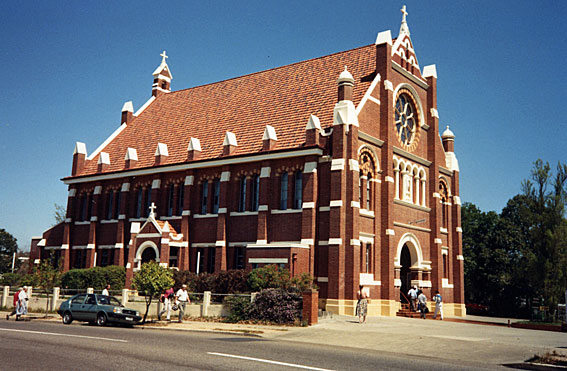
Sacred Heart Catholic Church, Rosalie
[Photograph by Howard Baker (1990s)]

Sacred Heart Catholic Church, Rosalie
[Photograph by Howard Baker (1990s)]
Historical and Technical Documentation by Geoffrey Cox
© OHTA 1989, 2011, 2012, 2017 (last updated December 2017)
Sacred Heart Church at Rosalie was built in 1917-18, replacing an earlier timber church dating from 1907. The building was designed in Romanesque style by the distinguished architect, George Henry Male Addison (1857-1922), who arrived in Brisbane in 1886.1 Addison's other buildings include the Albert Street Wesleyan Church (1889) and the Exhibition Building, Bowen Park (1891).
The organ was built by J.W. Walker & Sons, London, for St Mark's Anglican Church, Warwick. It had been ordered in August 1884 through W.H. Paling & Co of Sydney by their branch in Toowoomba,2 and is listed in the Walker Ledger as Job No. 1197.3 The instrument was installed at St Mark's by Mr Burnell, the manager of Paling's Toowoomba branch, in January 1886, and was formally opened and dedicated by Bishop Webber on Sunday 21 February.4 By April that year, it was reported that "The new organ at St Mark's Church (Warwick) has been thoroughly tested by Mr. Dutton, organist and choirmaster, with the most satisfactory results."5
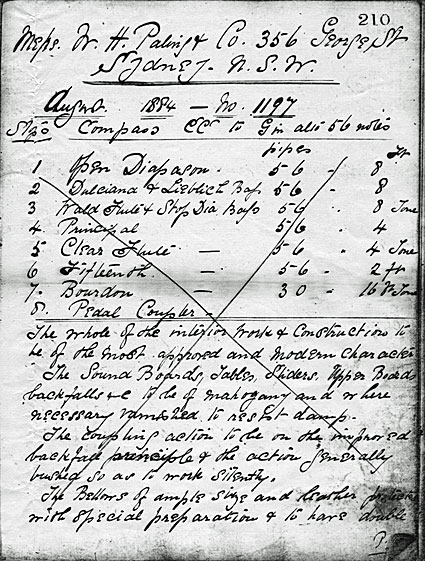
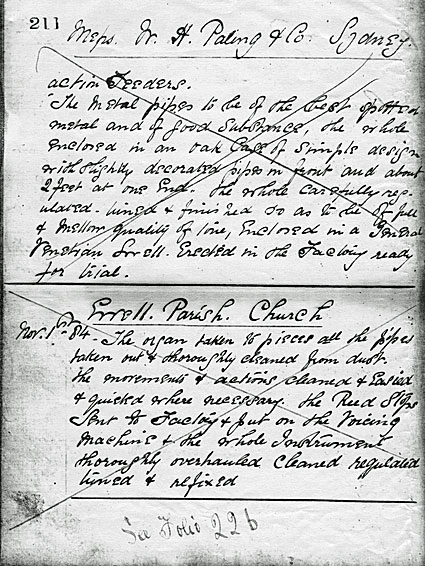
J.W. Walker & Sons Ledger Book E (1875-1884), pp. 210-11.
[J.W. Walker & Sons Ltd, Brandon, Suffolk]
The specification of the instrument in the Walker Ledger (see above) includes references to "Sound Boards, Tables, Sliders, Upper Boards, back falls etc to be of mahogany and where necessary varnished, to resist damp ... The metal pipes to be of the best spotted metal and of good substance, the whole, enclosed in an oak case of simple design with slightly decorated pipes in front and about two feet at one end".6
This instrument is a rare example of the builder's work in Queensland. Of the three organs built by the Walker firm for Queensland churches in the nineteenth century,7 this is the only one to survive with its original mechanical action intact. Numerous instruments by the firm were imported to other parts of Australia in the nineteenth century, including some 37 single-manual instruments of similar size to this one, dating mostly from the 1860s and 1870s.8 Some of these survive in original (or near original) condition, in churches in New South Wales and Tasmania, including those at St Mary's Catholic Church, Mudgee, NSW (1866; 7 stops), St Andrew's Anglican Church, Westbury, Tas (1867; 7 stops), St Andrew's Anglican Church, Evandale, Tas (1867; 4 stops), Anglican Church of the Good Shepherd, Kangaroo Valley, NSW (1879; 4 stops), St Mark's Anglican Church, West Wollongong, NSW (1880, 7 stops) and Benedict XVI Retreat Centre, Grose Vale, NSW (1882; 3 stops). Of these, the Wollongong instrument provides the nearest comparison to Rosalie in terms of both its specification and appearance.
Having been replaced at St Mark's, Warwick, by a larger instrument in 1923, the organ was sold by Whitehouse Bros of Brisbane in 1925 to Sacred Heart Church,9 where it was installed on the left-hand side of the gallery.
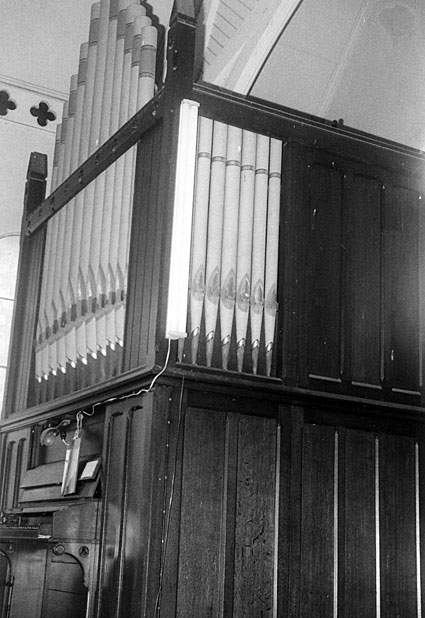
The organ in its original position at Sacred Heart Church
on the left-hand side of the gallery
[Photograph by Geoffrey Cox (1974)]
The instrument was damaged by fire some time around or before February 1942, and the Whitehouse Bros ledger entry for December that year records repairs as follows:10
| 1942 Dec 18 |
Repairing, rebuilding, replacing parts damaged by fire & water" as per our quote 3rd Feb 1942 Staining & polishing Outside case Decorating show pipes |
£330 £9 £15 18s ________ £354 18s |
As the Whitehouse repairs of 1942 refer to 'decorating show pipes', Walker's original 'slightly decorated' diapering of the façade pipes may have been altered at this time. Indeed, the diapering of the façade at Rosalie shows many similarities to that on Whitehouse organs at the Presbyterian Church, Fortitude Valley (1922), St John's Presbyterian Church, Annerley (1930) and the Methodist Church, Wooloowin (1948). The original builder's plate on the organ had been removed by the time details were noted by Bernie Brohan in the early 1950s.11
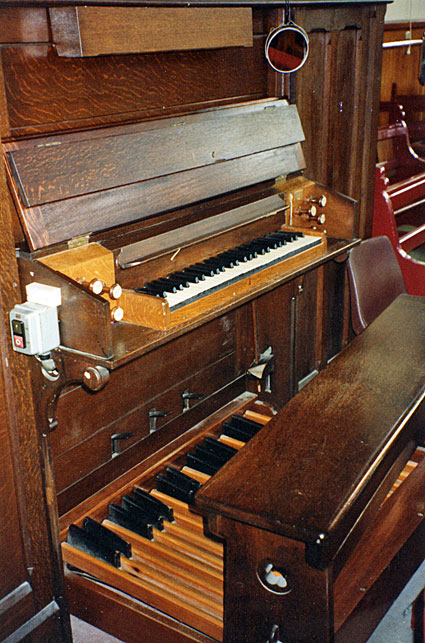
The console of the J.W. Walker & Sons organ
[Photograph by Howard Baker (1990s)]
The organ was moved by H.W. Jarrott of Brisbane from the gallery to a position on the south side of the nave around 1976. Jarrott restored the instrument in 1982, at which time he noted that there was still evidence of the earlier fire damage in the charred top timbers of the swell box, and in the fact that four large wooden tenor pipes had been provided inside the organ, replacing fire-damaged façade pipes. He observed that the tongue-and-groove wooden panels on either side of the façade pipes were not original, these having been added when fire-damaged façade pipes were replaced in 1942.12 The diapering on the pipe mouths appears to have been over-painted in gold at this time.
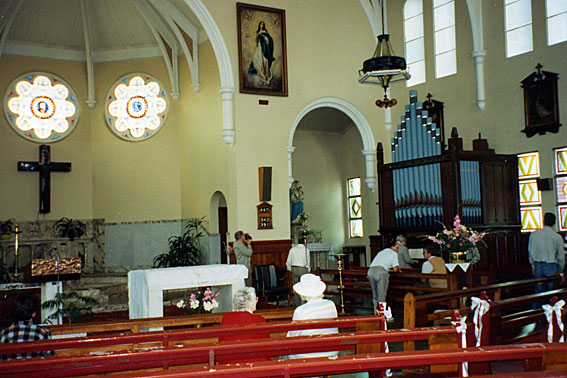
The organ in its location in the nave between c.1976 and 2016
[Photograph by Howard Baker (1990s)]
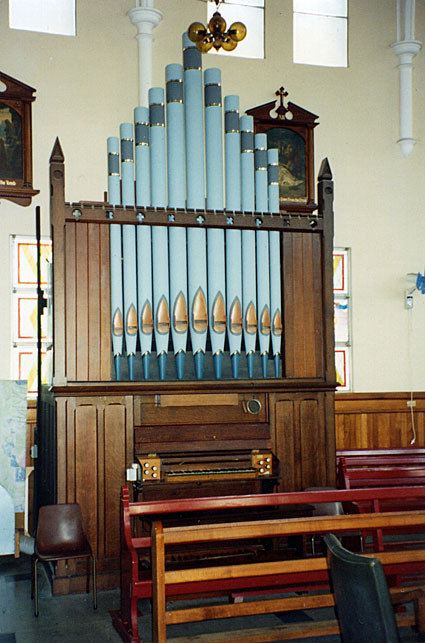
The façade of the organ after 1982,
showing the over-painting of the pipe mouths
[Photograph by Howard Baker (1990s)]
All of the pipework apart from the Pedal Bourdon 16 and the Open Diapason showpipes is enclosed in a swell box with horizontal shutters. The seven pipes in the small flat on the right-hand side of the organ are non-speaking. The Walker Ledger (above) shows that there was no side flat on the left-hand side, presumably because the organ was intended originally to be placed on the left-hand side of the gallery at St Mark's, Warwick.
| MANUAL [enclosed] Open Diapason Wald Flute & Stop'd Bass Dulciana Lieblich Bass Clear Flute Principal Fifteenth PEDAL Bourdon COUPLER Manual to Pedal |
8 8 8 4 4 2 16 |
Compass: 56/30
Originally handblown
Mechanical action
Lever swell pedal
Pedalboard: radiating & concave
3 composition pedals.13
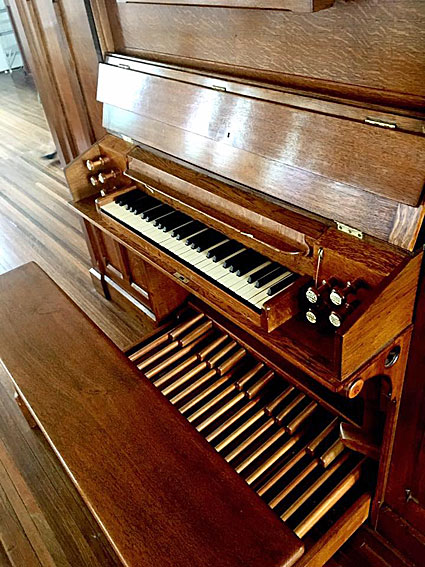
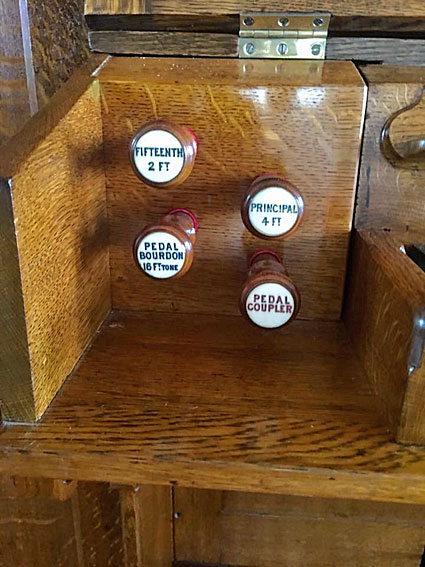
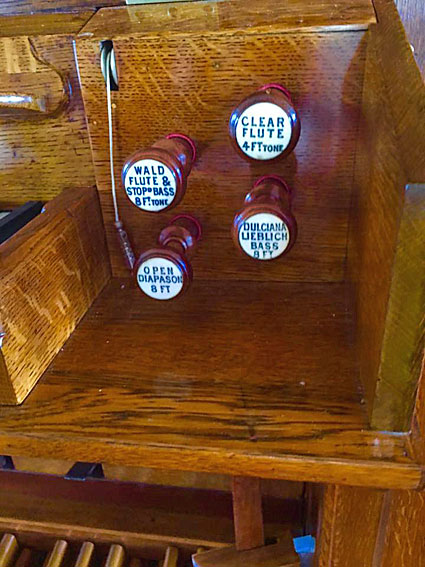
Console details of the restored organ
[Photographs by James Goldrick (October 2017)]
The organ was restored in 2017 by Pierce Pipe Organs of Brisbane, at which time it was re-located to the gallery. It now occupies a central position beneath the rose window, and its acoustic effect in the building has been enhanced by a new stone floor in the nave. The work included a complete restoration of the action and soundboard, returning the bellows from single-rise to double-rise, and restoring metal pipes to the façade that had been replaced by wooden stopped pipes (inside the organ) after the fire of 1942.14 On the understanding that the organ had never been supplied with casework on the left-hand side (although the Walker Ledger described 'the whole [as] enclosed in an oak case of simple design'), new panels were supplied in Tasmanian Oak, stained and polished to match the original English Oak casework.15 Parts of the pipe mouths in the façade were further over-painted in red, and a new (non-original) flat was added on the left-hand side to balance the original one on the right-hand side.
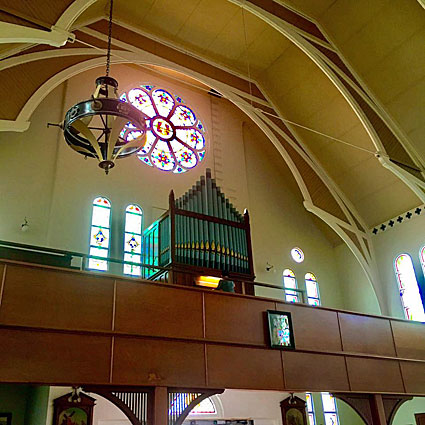
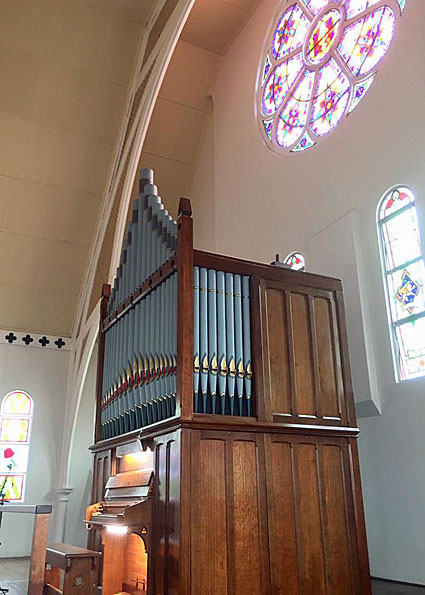
The restored organ re-located to the gallery
[Photographs by James Goldrick (October 2017)]
____________________________________________________________________________
1 Donald Watson & Judith McKay, Queensland Architects of the 19th Century: A Biographical Dictionary (Brisbane: Queensland Museum, 1994), pp. 5-6.
2 Annual Report of St Mark's Church (15 April 1884), cited in personal communication from Miss Muriel Stay (organist) to G. Cox, 2 June 1974; Personal communication from A. Dingwall (of J.W. Walker & Sons) to G. Cox, 29 July 1974.
3 Walker Ledger Book E (1875-1884), pp. 210-11 [J.W. Walker & Sons Ltd, Brandon, Suffolk].
4 The Brisbane Courier (30 January 1886), p. 6; The Warwick Argus (19 January 1886), p. 2; The Warwick Argus (16 February 1886), p. 2; The Brisbane Courier (20 February 1886), p. 5; The Brisbane Courier (23 February 1886), p. 6.
5 The Brisbane Courier (9 April 1886), p. 6.
6 J.W. Walker & Sons Ledger Book, op. cit.
7 The firm 'J.W. Walker, London' became 'J.W. Walker & Sons' after 1868. The other two Queensland organs were for St Paul's Anglican Church, Ipswich (1860) and St Andrew's Anglican Church, South Brisbane (1884).
8 Graeme Rushworth, Historic Organs of New South Wales: The Instruments, Their Makers and Players, 1791-1940 (Sydney: Hale & Iremonger, 1988), pp. 334-42.
9 Whitehouse Bros Ledger (1922-1940), pp. 181, 231, 249.
10 Whitehouse Bros Ledger (1940-1954), p. 315.
11 Collected Organ Specifications of Bernie Brohan (c.1952).
12 Personal communication from H.W. Jarrott to G. Cox, 1987, recorded in Organ Society of Queensland Newsletter, vol. 16, no. 1 (August 1988), pp. 11-14.
13 Specification noted by G. Cox, 1974 and 1987.
14 'News from the Organ Builders: Two Single-Manual Restorations,' Organ Australia, no. 2 (2016), pp. 35-36.
15 Simon Pierce, 'Three Restorations and a New Organ,' Organ Australia, no. 2 (2017), pp. 39-40.